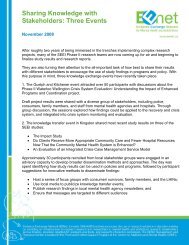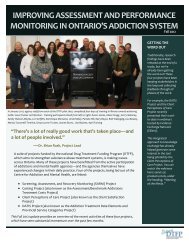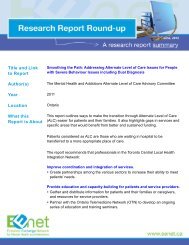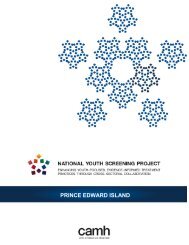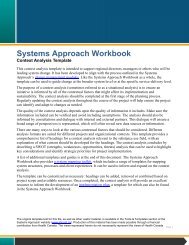Implementation of Early Psychosis Intervention Program ... - EENet
Implementation of Early Psychosis Intervention Program ... - EENet
Implementation of Early Psychosis Intervention Program ... - EENet
Create successful ePaper yourself
Turn your PDF publications into a flip-book with our unique Google optimized e-Paper software.
28IIISurvey ResultsResults are reported for the 52 program sites delivering care to young people with first episodepsychosis. The following sections report program descriptive data and then the results for eachStandard element, including quantitative results and key themes that emerged from the open textquestions.Provincial <strong>Program</strong>s Description<strong>Program</strong> size and staffing by catchment area population sizeAs indicated in Table 1A, the catchment population size for the program sites ranged from small(serving a population base <strong>of</strong> less than 20,000) to large (serving a community <strong>of</strong> more than500,000). <strong>Program</strong>s serving a larger catchment population tended to be located in urban or mixedurban/rural areas. These programs also reported higher budgets, total client caseload, andnumber and diversity <strong>of</strong> clinical (non-physician) staff. While caseload sizes per staff varied,there were no systematic differences between the programs with larger and smaller catchmentpopulation sizes.Throughout this report, the category ‘large program site’ includes sites that served catchmentpopulation sizes <strong>of</strong> greater than 100,000 population (60% <strong>of</strong> sites). These program sites also:o reported larger program budgets (mean budget <strong>of</strong> $340K or more)o were more likely to be located in major urban areas 46 (for example Toronto, Ottawa, Londonand other large Ontario cities);o reported more total clients registered at their site (mean <strong>of</strong> 50 or more);o employed more clinical staff (mean <strong>of</strong> 3.2 full time equivalent (FTE) staff or more)o had more disciplines and specialties represented on their team (mean <strong>of</strong> 3.7 or more)Comparatively, the ‘small program site’ category includes sites that served catchmentpopulation sizes <strong>of</strong> 100,000 or fewer people (40% <strong>of</strong> sites). These program sites also:o reported smaller program budgets (mean budget <strong>of</strong> $120K or less);o were located mainly in mixed urban and rural areas;o reported fewer total clients registered at their site (mean <strong>of</strong> 19 or less);o employed fewer clinical staff (mean <strong>of</strong> 1.1 FTE staff or less)o had fewer disciplines and specialties represented on the program site team (mean <strong>of</strong> 1.7 orless).46 While large programs tend to serve urban areas, there are programs in the ‘large program’ category that servevery large geographic areas (e.g., in the North). In this report, the results for large and small program sites arereported separately to illustrate differences these sites may experience in service delivery, in part due to urban/ruraldifferences. However, this categorization may mask some <strong>of</strong> the challenges faced by large programs which alsohave large geographic catchment areas to serve.



